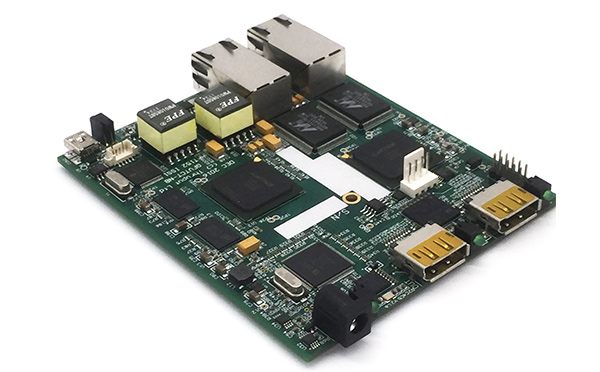
There are many ways to classify flexible PCB products. According to the number of FPC laminating layers, they can be divided into single panel, double panel, multilayer board and soft and hard combined board. FPC as a common type of circuit board, its market share is increasing with the development of electronic products to miniaturization and portability. However, FPC may have defects such as open circuit, short circuit and line width discrepancy in the process of processing, feeding and mounting.
Different production processes make it have many unique characteristics:
(1) High assembly density reduces the connection between parts;
(2) Light weight, thin thickness, can effectively reduce the weight of the product, easy to carry;
(3) Foldable, can be folded and bent arbitrarily.
FPC has the advantages of good reliability, strong heat dissipation, easy installation and low comprehensive cost, which provides convenience for the high integration and high performance of electronic products.
Development status of defect detection technology for flexible circuit boards
Most of the existing FPC defect detection algorithms are derived from PCB detection algorithms. However, limited by its uniqueness, FPC board defects require higher accuracy, larger sample size, and easy deformation of sample image, which makes the defect detection algorithm for PCB board cannot be directly applied to FPC board detection algorithm. An appropriate detection algorithm should be developed according to the actual circuit characteristics of the FPC board.
Aiming at the problems of slow speed and low accuracy of traditional template matching algorithm, China Jiliang University proposed to divide FPC board line defects into global defects and local defects. The eight-connected domain area method combined with histogram matching method was used to capture global defects in images. On this basis, projection matching and correlation coefficient method were used to identify local defects in images. This method is faster and more accurate than the traditional detection algorithm, but the classification of related defect categories is not detailed enough.
Analysis of defect detection method for flexible circuit board
To solve the global template matching problem, a local template matching method is considered to implement FPC defect detection. Considering the contour based template matching method, the template should have significant contour characteristics. Although the conventional lines on FPC have regular trend, they have no significant shape characteristics. Moreover, the conventional lines are distributed in the whole image, and the matching time of large-format template is too slow, which is not good for line detection.
Special-shaped lines belong to the irregular shape of the FPC, generally including LED lights, S-shaped circles, etc. Because it is related to the peripheral shape, its wiring is generally related to the style structure of the FPC to be examined. For such lines, the template matching method was considered to carry out detection. Firstly, the position and pose of each profiled-shaped line on the whole FPC were roughly located through the template matching method, and the contour of the profiled-shaped line was obtained. Then defect detection is carried out based on morphological theory.

Guide to Defect detection methods for flexible circuit boards
(1) Load the relevant data information of the registration template, including the scope of the registration template and the outline of the registration template.
(2) Using the regional information carried by the registered template, the template search space is located, and the template instance is searched in the search image based on the normalized cross-relation number (NCC) metric principle.
(3) Cut special-shaped areas. The dimension of the shaped area can be obtained by obtaining the minimum enclosing rectangle of the shape template instance. Since the shape template is a rectangular area, the area obtained by the minimum enclosing rectangle is the matched shaped area. Arbitrary template matching can not make two images perfectly aligned in space, there is a match within the allowable range. The deformation in the local range of FPC board can be ignored, and the shape template matching in the limited space is improved because of the narrowing of the space range, and the overall matching error is about 1/5 line width (3 pixels), which is in the allowable range of defect determination.
(4) Considering the accuracy error of shape matching, before the direct difference between the standard template image and the irregular area image, small size structural elements were used to corrode the irregular area to remove the impact of boundary difference. When there are defects in the image, the corrosion operation at this size cannot completely corrode the defective line, so it does not affect the final judgment result.
(5) Carry out regional difference set operation between template image and irregular region to obtain the difference region between them. When there is no defect, the difference is 0. When there is a defect, the region difference set returns a binary image that is not zero.
(6) Mark the connected domain of the difference image and segment different defect blocks;
(7) Calculate the area of each connected domain, take the geometric size center of the largest defect block as the center of the shaped area, and output the defect information.
The FPC defect detection methods are studied globally and locally, and experimental conclusions are drawn:
(1) Due to the deformation of FPC imaging, the template matching circuit based on the global scope is misaligned, and the defect information on the image cannot be correctly located.
(2) Based on the local template matching, firstly, the circuit area with significant shape characteristics compared with the conventional circuit on the FPC board is cut out and used as the template; The case detection is carried out near the corresponding template area on the search image to compress the search space. Then the circuit defect information is detected based on morphological theory.
In short, circuit board as the most basic component of electronic circuit, greatly affects the quality of the whole electronic products. Therefore, how to achieve accurate detection of circuit board defects is an important link of product quality assurance. However, most domestic enterprises generally rely on manual visual inspection for FPC defect detection, which has high cost and low efficiency. Moreover, due to the lack of relatively standardized quality inspection standards, staff are prone to miss and false detection due to subjective consciousness or visual fatigue. The excellent foreign testing equipment introduced by some enterprises is limited by equipment price, technical support and after-sales service, so it is difficult to adapt to the low cost and mass production needs of modern technology. Therefore, it is urgent to develop a fast and efficient automatic FPC defect detection system to meet the demand of the domestic market.







